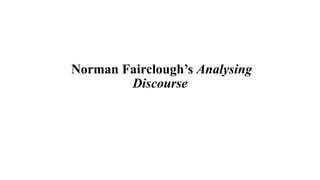Fairclough-Brief.pptx
•Télécharger en tant que PPTX, PDF•
0 j'aime•18 vues
Fairclough notes
Signaler
Partager
Signaler
Partager

Recommandé
Contenu connexe
Similaire à Fairclough-Brief.pptx
Similaire à Fairclough-Brief.pptx (20)
Discourse analysis of power in colonial texts in indonesia

Discourse analysis of power in colonial texts in indonesia
2011 - The Language Of Research Argument Metaphors In English And Lithuanian...

2011 - The Language Of Research Argument Metaphors In English And Lithuanian...
Construing Criticality in essay genre in English literature

Construing Criticality in essay genre in English literature
Plus de umarashaheen2
Plus de umarashaheen2 (17)
Reading Comprehension IELTS+ Critique Writing.pptx

Reading Comprehension IELTS+ Critique Writing.pptx
Revised-Importance of Communication Skills -Process.pptx

Revised-Importance of Communication Skills -Process.pptx
Extempore Speaking: Strategies and Techniques.pptx

Extempore Speaking: Strategies and Techniques.pptx
Focus on the Language Learner and Different Language Learning Strategies.pptx

Focus on the Language Learner and Different Language Learning Strategies.pptx
Dernier
Making communications land - Are they received and understood as intended? we...

Making communications land - Are they received and understood as intended? we...Association for Project Management
TỔNG ÔN TẬP THI VÀO LỚP 10 MÔN TIẾNG ANH NĂM HỌC 2023 - 2024 CÓ ĐÁP ÁN (NGỮ Â...

TỔNG ÔN TẬP THI VÀO LỚP 10 MÔN TIẾNG ANH NĂM HỌC 2023 - 2024 CÓ ĐÁP ÁN (NGỮ Â...Nguyen Thanh Tu Collection
Dernier (20)
On National Teacher Day, meet the 2024-25 Kenan Fellows

On National Teacher Day, meet the 2024-25 Kenan Fellows
Making communications land - Are they received and understood as intended? we...

Making communications land - Are they received and understood as intended? we...
Micro-Scholarship, What it is, How can it help me.pdf

Micro-Scholarship, What it is, How can it help me.pdf
TỔNG ÔN TẬP THI VÀO LỚP 10 MÔN TIẾNG ANH NĂM HỌC 2023 - 2024 CÓ ĐÁP ÁN (NGỮ Â...

TỔNG ÔN TẬP THI VÀO LỚP 10 MÔN TIẾNG ANH NĂM HỌC 2023 - 2024 CÓ ĐÁP ÁN (NGỮ Â...
UGC NET Paper 1 Mathematical Reasoning & Aptitude.pdf

UGC NET Paper 1 Mathematical Reasoning & Aptitude.pdf
Kodo Millet PPT made by Ghanshyam bairwa college of Agriculture kumher bhara...

Kodo Millet PPT made by Ghanshyam bairwa college of Agriculture kumher bhara...
Interdisciplinary_Insights_Data_Collection_Methods.pptx

Interdisciplinary_Insights_Data_Collection_Methods.pptx
Unit-V; Pricing (Pharma Marketing Management).pptx

Unit-V; Pricing (Pharma Marketing Management).pptx
Jual Obat Aborsi Hongkong ( Asli No.1 ) 085657271886 Obat Penggugur Kandungan...

Jual Obat Aborsi Hongkong ( Asli No.1 ) 085657271886 Obat Penggugur Kandungan...
Fairclough-Brief.pptx
- 2. Social analysis, discourse analysis, text analysis • 2C Fairclough’s approach (called ‘Critical Discourse Analysis’) assumes that there is a dialectical relationship between language and other elements of social life. • 2D There are two main kinds of discourse analysis: • (a) Textually-Oriented Discourse Analysis (TODA) • (b) non-TODA (for example, Michel Foucault’s approach) • Fairclough’s approach tries to combine these two. • 3A The focus of his approach ‘oscillates’ between both: • (a) specific texts (linguistic analysis) • (b) orders of discourse (interdiscursive analysis)
- 3. …………………………………………..…..Continued Order of discourse = ‘the relatively durable social structuring of language which is itself one element of the relatively durable structuring and networking of social practices.’ Interdiscursive analysis = ‘seeing texts in terms of the different discourses, genres and styles [that] they draw upon and articulate together’ 3B NF’s approach to the linguistic analysis of text is part of a broader project in social research. There is a ‘manifesto’ about this broader project in the Conclusion chapter (p. 202). Terminology: text, discourse, language 3C Text = ‘any actual instance of language in use’ ‘Language’and ‘Discourse’ can be used in either a general or a particular way. ‘Discourse’ = (a) general meaning: language in use as an element of social life which is closely interconnected with other elements. (b) particular meaning: e.g. New Labour ‘Third Way’ discourse